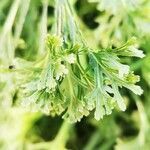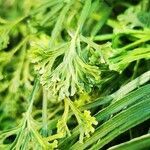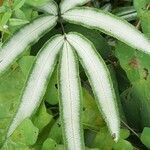Rhizome shortly decumbent, sparsely branched, up to 6 mm in diam., with closely spaced stipe bases and scales; scales castaneous, linear, subulate or narrowly lanceolate, up to 5 x 1 mm. Fronds closely spaced, erect to arching, dimorphic, up to 14 per plant, fertile longer than sterile; sterile up to 510 mm long; fertile up to 750 mm long. Stipe proximally castaneous, stramineous higher up, adaxially shallowly sulcate; sterile up to 360 mm long; fertile up to 575 mm long, up to 2.2 mm in diam. Lamina ovate; sterile up to 285 x 200 mm; fertile up to 305 x 250 mm; 1-pinnate, basal pinnae 2-pinnate, with up to 4 pinna pairs. Rachis stramineous, sulcate adaxially, glabrous. Pinnae herbaceous, opposite to alternate, basal pinnae largest, with up to 2 pinnules basiscopically, strongly inequilaterally triangular, sterile up to 155 x 75 mm, fertile up to 205 x 90 mm, distal pinnae simple, linear-attenuate, sterile up to 18 mm wide, fertile up to 10 mm wide, cuneate to inequilaterally cuneate, basiscopically decurrent along rachis, serrate, fertile entire, except for sterile apex; pinna rachis adaxially shallowly sulcate, sulcus confluent with that of rachis; petioles up to 4 mm long. Pinnules sessile, simple, linear-attenuate, sterile up to 90 x 11 mm, fertile up to 135 x 9 mm, acroscopically narrowly cuneate, basiscopically cuneate to decurrent; costa adaxially shallowly sulcate, without costular prickles; venation evident, simple or once forked. Sori linear, continuous along a marginal vascular commissure, extending most of length of fertile pinnae and pinnules; receptacle with paraphyses simple, pluricellular, up to 0.5 mm long.
Rhizome creeping or ascending, ca. 1 cm in diam., apex with black-brown scales. Fronds clustered, dimorphic or subdimorphic; stipe straw-colored, sometimes brown, seldom castaneous, 10-45 cm. Sterile fronds: stipe shorter, ca. 2 mm in diam., glabrous; lamina 1-pinnate or sometimes digitate, ovate in outline, 10-30[-40] × 6-20[-35] cm; pinnae (2 or)3-5(-7) pairs, often opposite, decumbent, basal pinnae each with 2(or 3) pinnules, shortly stalked, upper pinnae narrowly lanceolate or lanceolate, sometimes with basiscopic lobe, 10-18(-24) × 1-1.5(-3) cm, sessile, base broadly cuneate, margin white cartilaginous and serrate, apex acuminate. Fertile fronds longer: stipe 30-45 cm; pinnae 3-5(-8) pairs, opposite or upper alternate, decumbent, basal pinnae with (1 or)2(or 3) pinnules, shortly stalked (2-5 mm); upper pinnae linear, sometimes with lateral pinnule, 12-25 × 0.5-1.2 cm, sessile, base broadly cuneate, terminal pinna 3-lobed, base decurrent. Lamina green or gray-green, papery when dried, glabrous; midvein abaxially extremely convex, straw-colored, glabrous; veins conspicuous on both surfaces, distant, oblique, simple or forked at base. 2n = 58*, 59, 87*.
Stems slender, creeping, sparingly scaly; scales dark brown to chestnut brown. Leaves clustered to closely spaced, to 1 m. Petiole straw-colored to light brown distally, darker proximally, 10--50 cm, base sparsely scaly. Blade irregularly ovate, primarily and irregularly pedately divided, 10--30 × 6--25 cm; rachis not winged; only terminal pinna decurrent on rachis. Pinnae 1--3 pairs, well separated, blade often 5-parted with terminal pinna and 2 lateral pairs of pinnae remaining green through winter, not articulate; sterile pinnae to 25 × 0.8--1.5 cm, serrulate; fertile pinnae narrower than sterile pinnae, to ca. 11 mm wide, spiny-serrate; base acute acroscopically and decurrent (sometimes narrowly and barely so) basiscopically, glabrous; proximal pinnae with 1 (rarely 2) basiscopic lobes. Veins free, simple or forked. Sori narrow, blade tissue exposed abaxially.
Rhizome creeping, up to 10 mm in diameter, set with lanceolate, acuminate, entire, concolorous, dark brown rhizome-scales c. 3 mm long. Fronds tufted, erect, often dimorphous, firmly membranous to chartaceous; stipe stramineous to light brown, shallowly sulcate, glabrous, up to 0.65 m long; lamina ovate to deltate, mostly pinnate; pinnae and basal pinna-lobes linear-attenuate, the lower sessile, the upper adnate, decurrent, sterile margins of sterile and fertile pinnae bluntly to sharply serrate-dentate, sometimes undulate, sterile pinnae up to 110 x 24 mm, fertile pinnae up to 200 x 9 mm; veins free; rhachis stramineous, shallowly sulcate, glabrous. Sori in marginal lines extending for most of length of pinnae; indusium linear, subentire, membranous.
Rhizome short-creeping; scales minute, dark brown. Fronds dimorphic, clustered. Stipe to 50 cm long, stramineous, glabrous. Lamina oblong, 1-pinnate, incompletely 2-pinnate at the base; pinnae to c. 7 pairs, somewhat ascending, narrowly lanceolate, long-acuminate, chartaceous, glabrous; rachis not winged or slightly winged at apex. Lower pinnae short-stalked, in mature plants with 1 (–3) posterior short-stalked free conform pinnules. Upper pinnae sessile. Terminal pinna conform. Fertile pinnae slightly contracted; apex sterile, sharply dentate. Veins free, simple or once-forked; false veins absent. Sori continuous; indusium subentire; paraphyses numerous.
Rhizomes short-creeping, scaly. Stipes 25-75 cm long, ± devoid of scales except at very base. Laminae ovate or broadly ovate, 20-40 × 10-30 cm, 1-pinnate or with lower pinnae forked. Primary pinnae in 2-7 pairs, widely spaced, linear, tapering to acute apices, entire or minutely crenate at apices, 12-27 × 0.8-1.8 cm; upper pinnae adnate; lower pinnae stalked. Sori occupying whole of both margins of pinnae except at apices, protected by reflexed margins.
Terrestrial or epilithic. Rhizome shortly creeping. Fronds tufted, erect to arching, pinnate with basal pinnae bearing basiscopic subpinna, lamina ovate, 130-550 x 130-380 mm, dimorphous, sterile fronds half as long as fertile fronds, glabrous; sterile pinnae narrowly lanceolate, acuminate, margins serrulate-aristate; fertile pinnae linear, attenuate, margins entire. Sporangia in linear, marginal, continuous sori with entire, continuous indusium.
Rhizome creeping, set with dark brown rhizome scales. Upper pinnae simple (not pinnatifid), lower pinnae with 1 or 2 basiscopic lobes. Pinnae linear-attenuate, bluntly to sharply serrate-dentate. Sori in marginal lines.
Rhizomatous perennial. Fronds erect, soft, stipe glabrous, lamina deltate, 1-pinnate, basal pinnae 2-pinnate, pinnae linear, margins serrate-dentate. Null Sori in marginal lines, indusium linear, subentire.
A fern. It is slender and creeping and has a few scales. These are dark brown. The leaves are closely spaced and 1 m long. The leaf stalk is 10-50 cm long. The leaf blades are irregularly oval and divided.



